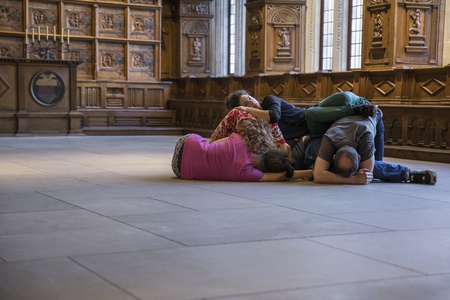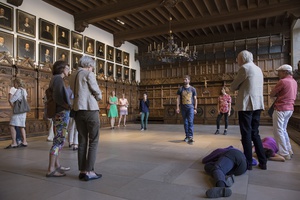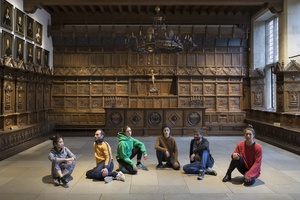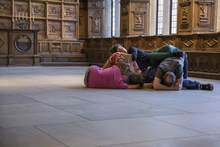Alexandra Pirici
Leaking Territories
2017
Location
Friedenssaal im Historischen Rathaus
(Historical Town Hall) Münster
Prinzipalmarkt 10
Performers
Beniamin Boar, Liliana Ferri De Guyenro, Montserrat Gardó Castillo, Susanne Grau, Susanne Griem, Jared Marks, Rolando Matsangos, Luísa Marinho Saraiva, Fang-Yu Shen, Tyshea Lashaune Suggs, Pia Alena Wagner, Andy Zondag
Alexandra Pirici
* 1982 in Bucharest, lives in Bucharest, Romania
In her works, Alexandra Pirici fuses ongoing action, dance, and sculpture. She frequently deals with the history and meaning of specific places in order to playfully tackle and transform existing hierarchies. She uses her interventions to confront the monumentality of public memorials and institutions with animated gestures that express a fundamental scepticism towards the chiselled stone forms of the past and canonical fixations. A further aspect of her work involves artistic reflections on data sovereignty and filter mechanisms within the digital space.
The Friedenssaal in Münster’s historic town hall served as the starting point for a work consisting of several parts: events which were primarily presented through media are restaged. In one sequence six performers form a collective body that dynamically cuts across the room, reconstructing an allusion to territorial conflicts and situations in which distinct lines of demarcation are challenged. This scene is strengthened by historic data and distances, giving the viewers a sense of orientation in time and space. Sporadically, the performers embody living search machines that interact with the audience. In part, the flow of visitors will overlap with the loop of ongoing action.
Pirici has situated her performance in a historic location. Today, the former town council and court chambers where the Treaty of Münster was signed in 1648 serve as a prestigious reception hall and a magnet for tourists. Within the context of the Peace of Westphalia — an act of diplomacy that brought to an end a war that was ostensibly religious but primarily hegemonic and specified territorial borders — the space symbolically stands for dialogue, tolerance, and the birth of international law. Pirici confronts this historic, museum-like re-enactment of the past by opening up the space for external influences and incorporating it in an associative, multi-perspectival network of references. The bodies serve as a medium and interface through which real media-related and mental time frames are connected — similar to a hypertext. By translating the movements back to three-dimensional forms of expression, history is updated in the medium: it takes place but is also made tangible in its constructedness. Pirici’s human-body collage raises a bunch of questions that revolve around the nation-state as a static, identity-establishing construct and the ambivalence of digital technologies. At a time when nationalism and protectionism are questioning the concept of Europe, Pirici’s work makes an appeal for a culture of transnational dialogue and a diversity of voices. In this way she can be loosely associated with a legal tenet that adorns one of the ceiling beams in the council chambers: Audiatur et altera pars — Let the other side be heard too.
Andreas Prinzing
Images
Location
- Still existing / Public Collection
- Removed
- In the museum



